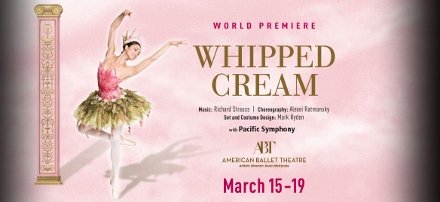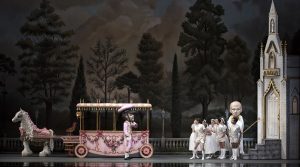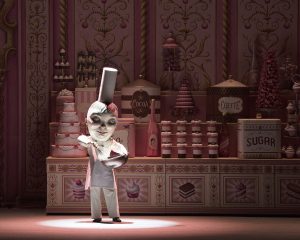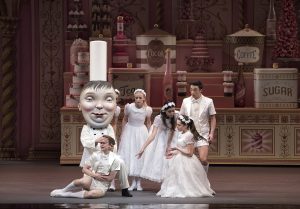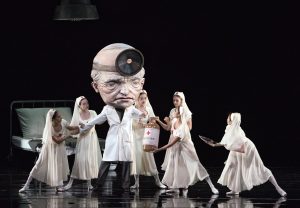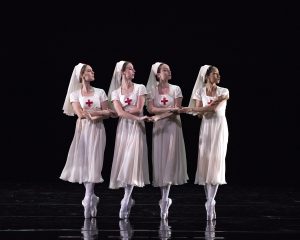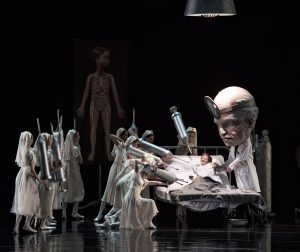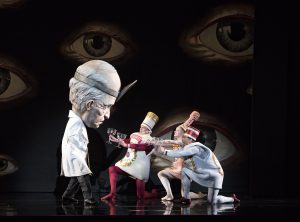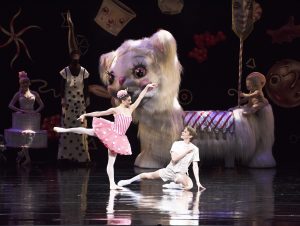WHIPPED INTO SUBMISSION
Explaining the creation of his 1924 two-act ballet, Richard Strauss stated, “I cannot bear the tragedy of the present time. I want to create joy.” Thus was born Schlagobers, which premiered at the Vienna State Opera. More sweet than meat, it was meant to satiate the angst caused by a brutal world war, but it was not well-received. Nearly a century after it was written, the now-titled Whipped Cream receives a brand new production from American Ballet Theatre and choreographer Alexei Ratmansky. Presented at So Cal’s Segerstrom Center in Costa Mesa last weekend, this creamy confection of a world premiere is as light as spun cotton candy.
As Strauss intended, this production is all about joy (although all political undertones have been removed here). Nothing wrong with that. Indeed, the music is closer in nature to Johann Strauss II (no relation) than the composer’s normally dark and psychological fare, and the story is a piece of cake, so it lends itself to an evening that’s all froth and no pepper. But it’s more successful in degrees than in its totality. The choreography comes in third, the dancing second (by a nose), and the winner out in front is the design. It should have been the other way around. I rate it three out of five scoops.
What’s a Boy (youthful Daniil Simkin, nailing high-flying leaps and turns) to do after his first time consuming bread and wine as memorials of Christ’s death? Why, go with all of his first-communion friends to an old-fashioned Viennese pastry shop right out of Main Street, U.S.A. The Boy overeats and gets tummy turnovers, and is taken to the doctor on a stretcher. Somehow, his sickness brings both his imagination and some of the sweets to life. Either that or these candy concoctions just come out to play after hours as in Toy Story.
No, I’m pretty sure the boy is somewhere else, and we’re witnessing his hallucinations: Princess Tea Flower (a luminous and grounded Gillian Murphy) is pursued by Prince Coffee (the strong but easily airborne James Whiteside); an interloping Lothario named Prince Cocoa (the lithe Joseph Gorak); and an overzealous Don Zucchero (a delightfully bumptious Arron Scott). Add to that the Princess’s Attendants, Marzipan Men, Sugarplum Men, and Gingerbread Men, and you’ve got one crowded shoppe.
In the next scene, the stage is all dry ice and whipped cream, and the 16 corp de ballet members come sliding down on their rumps into the Boy’s sugar-soaked dreams. Having not read the program yet, I surmised’”watching the mostly out-of-synch girls in all of that swirling white-and-pink mass’”that the locale is inside the boy’s stomach. Nope. It’s just a dream. End Act I.
At intermission, there’s a sense that the design is easily going to trump both dance and dancemaker. A former ballet dancer himself, Ratmansky trained at the Bolshoi Ballet School and was its artistic director before becoming artist in residence at ABT (this is his 13th piece for the company founded just 15 years after Schlagobers originally opened). I really love how he tweaks classical movement with fun and snappy Commedia dell’Arte-like moves. The issue is that they haven’t blended into a new art form that thrills, which explains why the second act gets a bit tiresome. (Currently, Christopher Wheeldon is the most successful with mashing up styles in story ballets.)
And while it’s thrilling and satisfying to see many traditional classical moves (sissones, batterie), it’s getting to the point where I wonder if the lack of symmetry in fingers, wrists, legs, et al.’”whether in a pas de quatre or corps de ballet’”is intentional or a result of sloppiness.
Pop surrealist Mark Ryden’s eye-popping set design (supervised by Camellia Koo) is rife with his trademark forms and figures; bunnies, babies, bees and even Abraham Lincoln will all make an appearance, which of course doesn’t make sense. I suppose the Boy’s sucrose-induced coma explains anything, and maybe he has seen a photo of the famous U.S. President, but it has nothing to do with the ballet. So the design is often incongruous with the narrative, which is shaky enough being one long Land of Sweets.
But the nightmarish quality is awesome: The mostly soft, feminine coloring is soothing while the frozen facial expressions of his characters are downright sinister. A Priest, Chef and Doctor all have giant heads, not unlike a paper maché creation standing tall above the crowd at a Fat Tuesday celebration. It’s as if Dr. Seuss and a Western and an antiques shop and an old-time burlesque show had been swirled together to create an all-new flavor, although Ryden didn’t go off the charts here as in his Memory Lane diorama, which had Abe Lincoln’s head painted pink and put on a baby’s naked body.
Ryden may have designed the costumes, but Holly Hynes brought them to life brilliantly (the purported $3 million price tag definitely showed in design). The rich multi-colored palette of textures in the pastry shop was clearly inspired by both sweets and the boxes used to wrap up fine desserts (macarons and meringue literally hang from some outfits).
The dizzying display of design continues in Act II, in which the Boy wakes up in a formidable hospital room bed with a giant eye blinking overhead. The large-headed intoxicated doctor (Alexei Agoudine) is accompanied by a gaggle of nurses carrying enormous hypodermic needles. The kid’s given a shot, so both he and the doctor are having a sweet high. The dopey doc dreams up three dancing liqueurs, the best representatives at elucidating Ratmansky’s vision of character-based choreography. Getting the hospital staff stiff are Mademoiselle Marianne Chartreuse (Catherine Hurlin), Ladislav Slivovitz (Duncan Lyle) and Boris Wutki (Roman Zhurbin); these audience favorites were a joy.
The distracting drinkables also allowed the appearance of Princess Praline (the lovely Sarah Lane, taking over for an injured Misty Copeland), who abets the Boy’s escape into a higher state of delirium. By now, he’s three sheets of cake to the wind, so into a European plaza comes a menagerie of Ryden’s childhood/nightmare creatures, including a “Long Neck Piggy,” the creepy “Worm Candy Man,” and a “Snow Yak” (which looks like a kitten doll from The Twilight Zone). Somehow, the Boy’s fitful phantasmagoria becomes reality as he falls in love and wins his pleasure prize, Praline, and they will now reside in the land of Nicolo (he’s some kind of Master of Ceremonies). It’s a good thing I read the synopsis, because I thought at the end that the Boy had died and gone to whipped cream heaven.
Snow yak? Lincoln? What’s going on? Why didn’t Ratmansky introduce characters at the start who infiltrated the Boy’s dreams so he returns from his sickness with a new outlook? (I know it’s been done, but think of the tried-and-true Wizard of Oz storyline.) It feels like Ratmansky started with one thing and ended up with another, leaving his designer to run wild. And, along with the Pacific Symphony led by conductor David LaMarche, that is certainly distraction enough. Just don’t try to understand what’s going on. If you overeat candy, you’ll get sick. If you over-analyze Whipped Cream, you’ll get a headache.
photos by Gene Schiavone
Whipped Cream
American Ballet Theatre
Segerstrom Center for the Arts
played March 15-19, 2017
for future dates and cities, visit ABT
